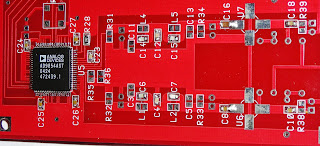
Hopefully this is what mine will look like soon.
It started off like this:

It currently looks like this: Some components just placed some soldered, (click any of the following images to zoom in for a close up image)

Now all I have are soldered (except torroids and PIC's waiting for 40 pin sockets):

I started this after 'refinding' my collection of AD chip samples after putting it away before going to HB9 in 2007! Right now the build is waiting for an order from Farnell and Digikey for a number of the SMD components and for a collection of the Hittite switches from FDIM (Craig).
Many of the components I had in the component supplies/junk box. Used 1/4 w rather than 1/8w resistors as those were what I have.

Although I doubled up some 1206 resistors to make the necessary values.
(tested with a meter for the correct resistance afterwards)

Over the last few evenings I have been winding toroids for several projects, including this one and they are all now in separate plastic bags.

It was interesting working on everything from FT240-43 to T20-2 and most sizes in between. A lot of the homebrew bench is being cleaned up and the shack tidyed. To allow me to work on 'clean items' (XYL defined) I also have a new tool box containing many of the different sizes of enamelled copper wire. Which allows me to wind these. Hopefully I will work out all my extra toroid orders (this set is full) before FDIM.
On the DDS-VFO yahoo group list I noted the new project by Paul Blum, K9ARF using the LNA/LPF and a really neat looking enclosure.

I had an exchnage with Craig as I was not sure I had started the LNA/LPF correctly as I seemed to have more boards than needed:
Hi Dom,
Yes, it may be confusing. Just remember that there are 7 LNAs needed for the full complement.
One of them is a "bypass" section for 160 meters and it just has the switches connected by a piece of coax. (It is still activated by a wire from the control section, just like the other LNAs.)There are 5 LPFs.
Each LNA "break-off board" handles two LNAs and each LPF "break-off board" handles two LPFs.
To handle all bands, including 160 meters, here's what you need:
1) One Main board (with PICs)
2) One DDS board
3) One "main LNA/LPF board" containing one LNA/LPF control section, two LNAs, buffer (2N5109 section) on LNA board, two LPFs
4) Three additional LNA sections, two of them containing 4 LNAs and the third containing just the LNA "bypass" section for 160meters. No 2N5109 section on these.
5) Two additional LPF sections, one populated with two LPFs and one populated with one LPF.
Hope that helps.-Craig, AA0ZZ
Further exchnages confirmed:
The LNA connections are listed LNA mute LNA1 to LNA6 and LNA engage None, LNA1 to LNA6.
The LPF connections are listed LPF engage LPF1 to LPF6
Actually, there are only 5 LPFs so LPF1 through LPF5 are used the last pin is a spare - just in case...but unused now.
This is important if you want the bands/code to operate correctly, on the master control board you connect the 7th 160m LNA to "NONE" LNA engage, you connect the other 6 LNA to LNA1 to LNA6. And the LPF to LPF1 to LPF5.

The coax needs to run between Hittite pin 1 U4 and pin 3 U5. When looking for a good place for this, the closest pads of C1 and C7 seemed appropriate and then between them. However as Craig pointed out there is a pad on each side for this coax connection. Jc and Jd. (Center and ground on each.)
Look above the letters undermeath and you'll find the connections

.........Jc.......................................................Jd
So as I have 4 of the boards with the control/lna/lpf section , the control sections on the top three boards and 1 LPF section are all surplus. You can snap them apart for a final assembly but keeping them together during the build makes it easier. Once done snap off the 3 control sections and one LPF section. On this picture that is the left most sections on top 3 boards and the upper right corner of the top board. (Click the image to zoom in) The picture is an early image as I was populating the SMD R and C from what I had.































































